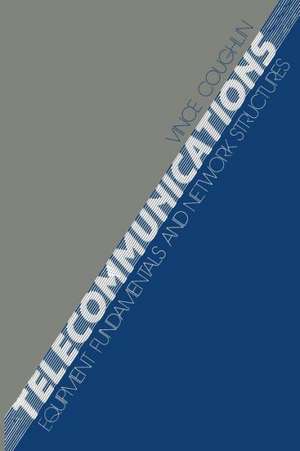Telecommunications: Equipment Fundamentals and Network Structures
Autor Vincent J. Coughlinen Limba Engleză Paperback – 7 mar 2012
Preț: 378.92 lei
Nou
Puncte Express: 568
Preț estimativ în valută:
72.51€ • 75.55$ • 60.03£
72.51€ • 75.55$ • 60.03£
Carte tipărită la comandă
Livrare economică 03-17 aprilie
Preluare comenzi: 021 569.72.76
Specificații
ISBN-13: 9789401160551
ISBN-10: 9401160554
Pagini: 144
Ilustrații: XII, 132 p.
Dimensiuni: 152 x 229 x 8 mm
Greutate: 0.2 kg
Ediția:Softcover reprint of the original 1st ed. 1984
Editura: SPRINGER NETHERLANDS
Colecția Springer
Locul publicării:Dordrecht, Netherlands
ISBN-10: 9401160554
Pagini: 144
Ilustrații: XII, 132 p.
Dimensiuni: 152 x 229 x 8 mm
Greutate: 0.2 kg
Ediția:Softcover reprint of the original 1st ed. 1984
Editura: SPRINGER NETHERLANDS
Colecția Springer
Locul publicării:Dordrecht, Netherlands
Public țintă
ResearchCuprins
1. The Medium and the Market — An Overview.- 1.1 A Telecommunications Overview.- 1.2 Understanding the Basics.- 1.3 A Bright Future with Fiber Optics.- 1.4 A View from the Business Side.- 2. Modems and Multiplexers.- 2.1 Introduction.- 2.2 The Role of Modems.- 2.3 Modem Applications.- 2.4 Industry Standards.- 2.5 Modem Features.- 2.6 Multiplexing Reduces Communications Cost.- 2.7 Multiplexer Technology.- 2.8 Statistical Multiplexer.- 3. Protocols and Codes.- 3.1 What is a Protocol?.- 3.2 Protocol Hierarchy.- 3.3 Physical Electrical Interface.- 3.4 Link Control Structure.- 3.5 Bisync Protocol.- 3.6 HDLC Protocol.- 3.7 SDLC Overview.- 3.8 System Network Architecture (SNA).- 3.9 Polling Explained.- 3.10 Transmission Codes.- 3.11 Code and Speed Converters.- 3.12 Treatment of Errors.- 3.13 Front-End Processors.- 4. Terminal Technology.- 4.1 CRT Display Terminals.- 4.2 Printing Technologies.- 4.3 Graphic Terminals.- 4.4 Facsimile Technology.- 4.5 Integrated Workstations.- 5. Network Management.- 5.1 Network Control Design Considerations.- 5.2 Elementary Monitoring.- 5.3 Redundancy and Compatability.- 5.4 Network Testing.- 5.5 Centralized Troubleshooting.- 5.6 Network Control Center.- 5.7 Specialized Test Equipment.- 5.8 Network Security.- 6. Network Structures.- 6.1 Topology Tradeoffs.- 6.2 Local Area Networks.- 6.3 Distributed Communications.- 6.4 Message Switching Networks.- 6.5 Integrated Voice and Data.- 6.6 Shared Resources.- 6.7 Packet Switching Networks.- 6.8 Network Design Considerations.- 7. Satellite and Carrier Services.- 7.1 Satellite Overview.- 7.2 Selecting a Transmission Method.- 7.3 Facsimile Services.- Glossary of Terms.

